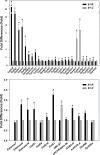Differentially expressed microRNAs associated with changes of transcript levels in detoxification pathways and DDT-resistance in the Drosophila melanogaster strain 91-R
- PMID: 29698530
- PMCID: PMC5919617
- DOI: 10.1371/journal.pone.0196518
Differentially expressed microRNAs associated with changes of transcript levels in detoxification pathways and DDT-resistance in the Drosophila melanogaster strain 91-R
Abstract
Dichloro-diphenyl-trichloroethane (DDT) resistance among arthropod species is a model for understanding the molecular adaptations in response to insecticide exposures. Previous studies reported that DDT resistance may involve one or multiple detoxification genes, such as cytochrome P450 monooxygenases (P450s), glutathione S-transferases (GSTs), esterases, and ATP binding cassette (ABC) transporters, or changes in the voltage-sensitive sodium channel. However, the possible involvement of microRNAs (miRNAs) in the post-transcriptional regulation of genes associated with DDT resistance in the Drosophila melanogaster strain 91-R remains poorly understood. In this study, the majority of the resulting miRNAs discovered in small RNA libraries from 91-R and the susceptible control strain, 91-C, ranged from 16-25 nt, and contained 163 precursors and 256 mature forms of previously-known miRNAs along with 17 putative novel miRNAs. Quantitative analyses predicted the differential expression of ten miRNAs between 91-R and 91-C, and, based on Gene Ontology and pathway analysis, these ten miRNAs putatively target transcripts encoding proteins involved in detoxification mechanisms. RT-qPCR validated an inverse correlation between levels of differentially-expressed miRNAs and their putatively targeted transcripts, which implies a role of these miRNAs in the differential regulation of detoxification pathways in 91-R compared to 91-C. This study provides evidence associating the differential expression of miRNAs in response to multigenerational DDT selection in Drosophila melanogaster and provides important clues for understanding the possible roles of miRNAs in mediating insecticide resistance traits.
Conflict of interest statement
Figures




Similar articles
-
RNAi validation of resistance genes and their interactions in the highly DDT-resistant 91-R strain of Drosophila melanogaster.Pestic Biochem Physiol. 2015 Jun;121:107-15. doi: 10.1016/j.pestbp.2015.01.001. Epub 2015 Jan 7. Pestic Biochem Physiol. 2015. PMID: 26047118
-
Post-transcriptional modulation of cytochrome P450s, Cyp6g1 and Cyp6g2, by miR-310s cluster is associated with DDT-resistant Drosophila melanogaster strain 91-R.Sci Rep. 2020 Sep 1;10(1):14394. doi: 10.1038/s41598-020-71250-0. Sci Rep. 2020. PMID: 32873850 Free PMC article.
-
High expression of Cyp6g1, a cytochrome P450 gene, does not necessarily confer DDT resistance in Drosophila melanogaster.Gene. 2007 Feb 15;388(1-2):43-53. doi: 10.1016/j.gene.2006.09.019. Epub 2006 Oct 5. Gene. 2007. PMID: 17134855
-
Resistance evolution in Drosophila: the case of CYP6G1.Pest Manag Sci. 2017 Mar;73(3):493-499. doi: 10.1002/ps.4470. Epub 2016 Dec 21. Pest Manag Sci. 2017. PMID: 27787942 Review.
-
Identification and interaction of multiple genes resulting in DDT resistance in the 91-R strain of Drosophila melanogaster by RNAi approaches.Pestic Biochem Physiol. 2018 Oct;151:90-99. doi: 10.1016/j.pestbp.2018.03.003. Epub 2018 Mar 14. Pestic Biochem Physiol. 2018. PMID: 30704719 Review.
Cited by
-
From Global to Local-New Insights into Features of Pyrethroid Detoxification in Vector Mosquitoes.Insects. 2021 Mar 24;12(4):276. doi: 10.3390/insects12040276. Insects. 2021. PMID: 33804964 Free PMC article. Review.
-
Impacts of Sub-lethal DDT Exposures on microRNA and Putative Target Transcript Expression in DDT Resistant and Susceptible Drosophila melanogaster Strains.Front Genet. 2019 Feb 5;10:45. doi: 10.3389/fgene.2019.00045. eCollection 2019. Front Genet. 2019. PMID: 30804985 Free PMC article.
-
Aedes aegypti miRNA-33 modulates permethrin induced toxicity by regulating VGSC transcripts.Sci Rep. 2021 Mar 31;11(1):7301. doi: 10.1038/s41598-021-86665-6. Sci Rep. 2021. PMID: 33790374 Free PMC article.
-
miRNAs of Aedes aegypti (Linnaeus 1762) conserved in six orders of the class Insecta.Sci Rep. 2021 May 21;11(1):10706. doi: 10.1038/s41598-021-90095-9. Sci Rep. 2021. PMID: 34021209 Free PMC article.
-
miRNA Dynamics for Pest Management: Implications in Insecticide Resistance.Insects. 2024 Mar 29;15(4):238. doi: 10.3390/insects15040238. Insects. 2024. PMID: 38667368 Free PMC article. Review.
References
-
- Casida JE, Quistad GB. Golden age of insecticide research: past, present, or future? Annu Rev Entomol. 1998;43: 1–16. doi: 10.1146/annurev.ento.43.1.1 - DOI - PubMed
-
- Roush RT, McKenzie JA. Ecological genetics of insecticide and acaricide resistance. Annu Rev Entomol. 1987;32: 361–380. doi: 10.1146/annurev.en.32.010187.002045 - DOI - PubMed
-
- Mallet J. The evolution of insecticide resistance: Have the insects won? Trends Ecol Evol. 1989;4: 336–340. doi: 10.1016/0169-5347(89)90088-8 - DOI - PubMed
-
- Hemingway J, Ranson H. Insecticide resistance in insect vectors of human disease. Annu Rev Entomol. 2000;45: 371–391. doi: 10.1146/annurev.ento.45.1.371 - DOI - PubMed
-
- Organization WH. Indoor residual spraying. Use of indoor residual spraying for scaling up global malaria control and elimination. Geneva, Switzerland (WHO/HTM/MAL/20061112); 2006.
MeSH terms
Substances
LinkOut - more resources
Full Text Sources
Other Literature Sources
Molecular Biology Databases
Research Materials
Miscellaneous

